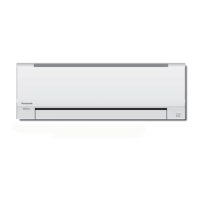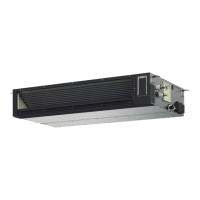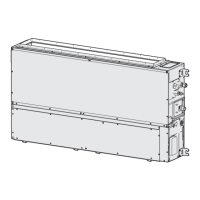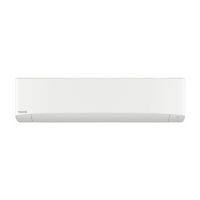What to do if refrigerant is leaking from my Panasonic S-15MK2E5B?
- TthomasfrederickAug 5, 2025
If you suspect a refrigerant leak, ventilate the room. Then, contact your service dealer for assistance.
What to do if refrigerant is leaking from my Panasonic S-15MK2E5B?
If you suspect a refrigerant leak, ventilate the room. Then, contact your service dealer for assistance.
Why is my Panasonic S-15MK2E5B making noise during heating?
The noise during heating operation could be due to the defrost operation in process.
General guidance on using the air conditioner safely and efficiently.
Identifies and illustrates the various components of the indoor and outdoor units.
Instructions on how to clean and maintain the air conditioner for optimal performance.
Technical data and operating ranges for indoor and outdoor units.
Guidelines for the correct installation of the air conditioner by qualified technicians.
Requirements and guidelines for electrical wiring installation to ensure safety and compliance.
Steps to prepare the unit for operation, including power-on timing.
Advice on how to use the air conditioner efficiently to save energy.
Information on the proper disposal and recycling of the product and batteries according to regulations.
Details on the wireless remote controller, including model numbers.
Information about the timer remote controller and its model number.
Details on the high-spec wired remote controller and its model number.
Information on the standard wired remote controller and its model number.
Instructions for cleaning and maintaining the air filters for optimal unit performance.
Steps to follow after cleaning the air filter, including reinstallation and reset procedures.
Explains how heating performance is affected by outside temperature.
Describes the defrosting operation, its indicators, and how the unit behaves during this process.
Explains the operation and fan speed behavior during DRY mode.
Details how the unit resumes operation after a power failure, retaining previous settings.
Addresses common issues and causes related to the indoor unit's operation.
Addresses various sounds heard from the indoor unit during operation or stopping.
Explains potential causes for odors in the discharged air.
Explains why dewdrops form near the air outlet during cooling.
Explains the phenomenon of fog appearing during cooling operation.
Explains the phenomenon of fog appearing during heating operation.
Describes why the fan may continue to rotate after the unit has stopped.
Addresses the issue of the indoor fan not stopping upon command, possibly due to refrigerant leak detection.
Covers issues related to the automatic adjustment and control of airflow direction.
Explains the cause of dust being discharged from the unit.
Explains the temporary high-speed fan rotation during initial operation.
Addresses common issues and causes related to the outdoor unit's operation.
Addresses why the unit might not operate immediately after power-on or restart.
Explains causes for noise during the heating cycle.
Explains the appearance of steam during heating operation.
Describes why the outdoor unit fan might continue to rotate after shutdown.
Crucial steps to check before contacting a service dealer for assistance.
Steps to take if the unit fails to start despite power being supplied.
Troubleshooting steps for reduced cooling or heating efficiency.
Detailed specifications for various indoor unit models, including capacity and dimensions.
Specifies the operating temperature limits for cooling and heating modes.
Specifications for the mini VRF outdoor units, covering various capacities and voltage types.
Specifies the operating temperature limits for cooling and heating modes.
Details the standard conditions under which the unit's performance is rated.
General guidance on using the air conditioner safely and efficiently.
Identifies and illustrates the various components of the indoor and outdoor units.
Instructions on how to clean and maintain the air conditioner for optimal performance.
Technical data and operating ranges for indoor and outdoor units.
Guidelines for the correct installation of the air conditioner by qualified technicians.
Requirements and guidelines for electrical wiring installation to ensure safety and compliance.
Steps to prepare the unit for operation, including power-on timing.
Advice on how to use the air conditioner efficiently to save energy.
Information on the proper disposal and recycling of the product and batteries according to regulations.
Details on the wireless remote controller, including model numbers.
Information about the timer remote controller and its model number.
Details on the high-spec wired remote controller and its model number.
Information on the standard wired remote controller and its model number.
Instructions for cleaning and maintaining the air filters for optimal unit performance.
Steps to follow after cleaning the air filter, including reinstallation and reset procedures.
Explains how heating performance is affected by outside temperature.
Describes the defrosting operation, its indicators, and how the unit behaves during this process.
Explains the operation and fan speed behavior during DRY mode.
Details how the unit resumes operation after a power failure, retaining previous settings.
Addresses common issues and causes related to the indoor unit's operation.
Addresses various sounds heard from the indoor unit during operation or stopping.
Explains potential causes for odors in the discharged air.
Explains why dewdrops form near the air outlet during cooling.
Explains the phenomenon of fog appearing during cooling operation.
Explains the phenomenon of fog appearing during heating operation.
Describes why the fan may continue to rotate after the unit has stopped.
Addresses the issue of the indoor fan not stopping upon command, possibly due to refrigerant leak detection.
Covers issues related to the automatic adjustment and control of airflow direction.
Explains the cause of dust being discharged from the unit.
Explains the temporary high-speed fan rotation during initial operation.
Addresses common issues and causes related to the outdoor unit's operation.
Addresses why the unit might not operate immediately after power-on or restart.
Explains causes for noise during the heating cycle.
Explains the appearance of steam during heating operation.
Describes why the outdoor unit fan might continue to rotate after shutdown.
Crucial steps to check before contacting a service dealer for assistance.
Steps to take if the unit fails to start despite power being supplied.
Troubleshooting steps for reduced cooling or heating efficiency.
Detailed specifications for various indoor unit models, including capacity and dimensions.
Specifies the operating temperature limits for cooling and heating modes.
Specifications for the mini VRF outdoor units, covering various capacities and voltage types.
Specifies the operating temperature limits for cooling and heating modes.
Details the standard conditions under which the unit's performance is rated.
| Brand | Panasonic |
|---|---|
| Model | S-15MK2E5B |
| Category | Air Conditioner |
| Language | English |












